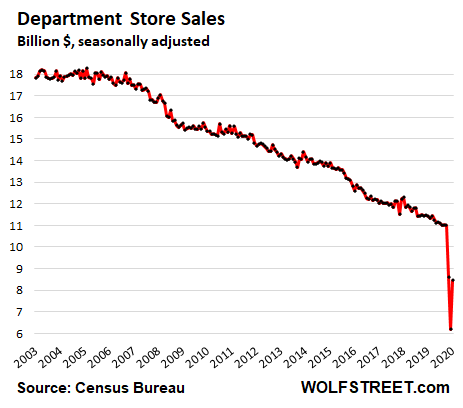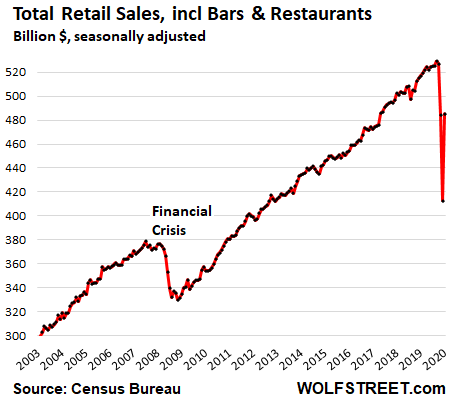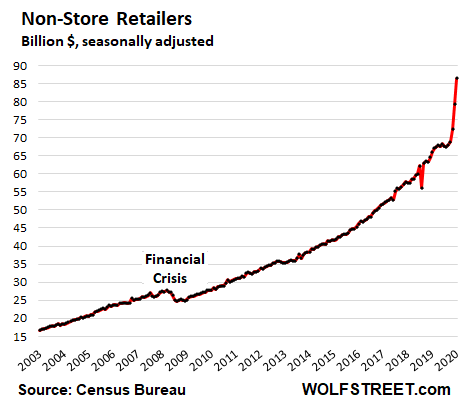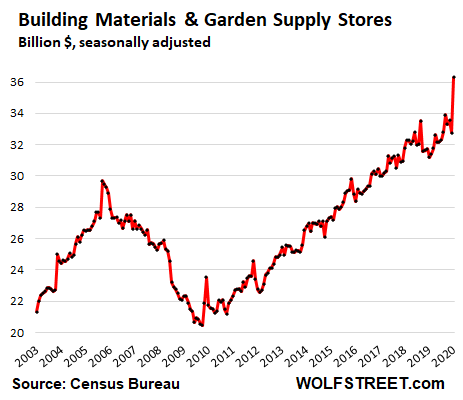Retail Sales by Segment in 12 Hair-Raising Charts
by Wolf Richter, Wolf Street:
 It’s a pandemic, so there are problems with the data.
It’s a pandemic, so there are problems with the data.
Total retail sales in May bounced off 17.7% from the April low, according to the Census Bureau today. April had been the lowest April since 2013. May retail sales, at $485 billion seasonally adjusted, were down 6.1% from May 2019, down 3.3% from May 2018, and up 2.6% from May 2017. It seems, people are spending their stimulus checks and their extra $600 a week in federal unemployment compensation.
Ecommerce sales skyrocketed 30% year-over-year to another record. Sales at building materials, garden supply, and equipment stores jumped to a new record. Other segments bounced off strongly, but remained at low levels. Two segments that had spiked in March – grocery and general merchandise stores – fell halfway back to earth in April, and stayed there in May. Department stores and clothing & accessory stores, though they too bounced, remained at horribly depressed levels that, other than April, were multi-decade lows. There is no good news for malls. We’ll get into each of those segments:

The pandemic impacts data collection, leading to large sampling errors and huge revisions.
The Census Bureau acknowledged, as it had done in April, that due to the pandemic, it changed its data collection procedures. This data is based on surveys sent to 5,500 randomly selected retail and food services locations, of the over three million such locations in the US. Normally, data are collected “on paper, online, fax, and through telephone interviews.” But due to the pandemic, it was collected “primarily via email requests and online reporting, supplemented by calling operations.” In addition, the Census Bureau said it altered the method of seasonal adjustments.
The same issues dogged the surveys in April. And so, as part of its data release today, the Census Bureau revised its April data. Revisions are normal. But some of the revisions for April were huge, up and down. The list below shows the percentage differences between the April dollar sales levels of the “advance estimate” released a month ago, and the revised data:
- Food services and drinking places: revised down -7.5%;
- Sporting goods stores revised up + 7.7%;
- Clothing and accessory stores revised up + 18.9%;
- General merchandise stores revised up + 10.5%,
- Furniture stores revised up + 23%.
- Overall retail sales revised up + 2.1%.
A month from now, we might also see these types of mindbogglingly large revisions of today’s retail sales for May.
The segments that spiked to new records
Sales at non-store retailers continued to spike from record to record. This category overlaps partially with ecommerce but also includes other types of retailers such as catalogue and mail-order operations, door-to-door sales, sales at temporary stalls and at vending machines. Fired up by the relentless boom in ecommerce, sales jumped 9% in May from April, and by 31% from May last year, to $86 billion:

Sales at building materials, garden supply and equipment stores (such as hardware stores and big-box stores like Home Depot) spiked 16.4% in May from April, and by 10.9% year-over-year, to $36 billion, a new record — which makes sense: people stuck at home with time and money, including stimulus money, fixing up their homes and building sheds in their backyards:

The other extreme: where sales remain abysmal.
Sales at department stores – not counting the online sales of department stores – had totally collapsed in March and April. In May they bounced but remained 26% below May last year. Department store sales have been declining since their peak in 2001. Countless chains have filed for bankruptcy over the years. Most were liquidated. Over the past two months, Neiman Marcus and JCPenney joined the bankruptcy club. Lord & Taylor is planning to. Year after year, surviving department stores have announced waves of store closings.
They were structurally being obviated. From the peak in 2001 through February 2020, monthly sales collapsed from $20 billion to $11 billion, despite inflation and population growth. In April sales collapsed to $6 billion. In May, sales bounced to $8.5 billion – a previously unimaginably low level, and still down 26% from the already depressed levels in May last year:

Last week, Macy’s CEO Jeff Gennette said that sales at stores that had been reopened for at least one week were about half of where they’d been before the pandemic. And before the pandemic, Macy’s – which invested massively into its booming ecommerce business – had been closing stores for years because their sales were already evaporating.



